Homemade Chicken Broth is scrumptious chicken-y goodness with added flavor from veggies and herbs. It’s healthy, delicious and it’s easy to make.
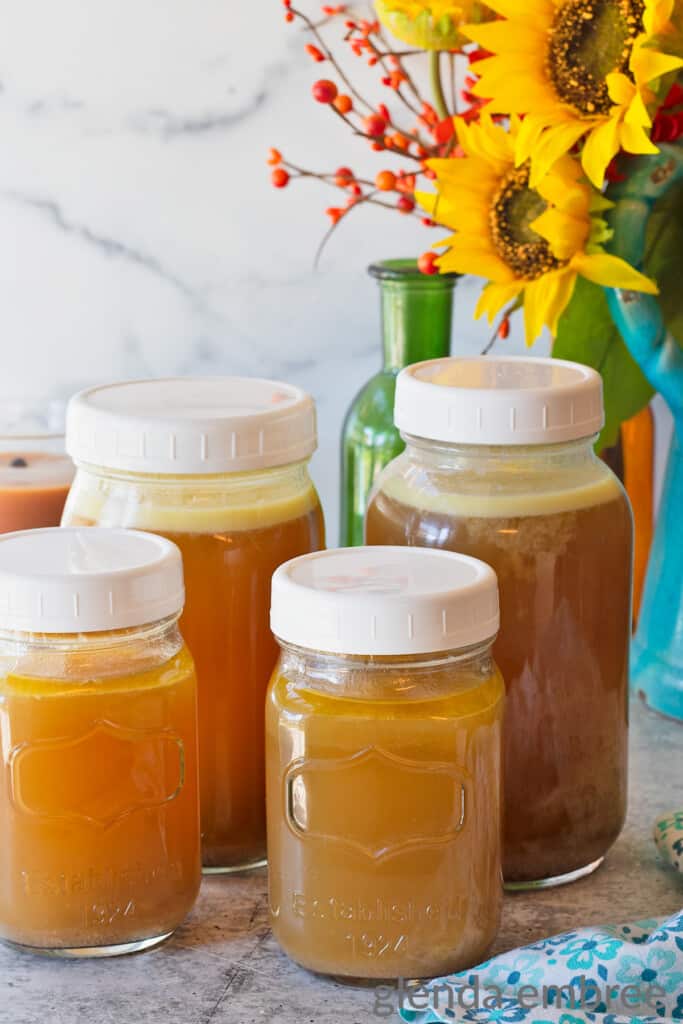
My homemade chicken broth recipe is unlike anything you will ever buy in a can or carton.
This is a whole food, real food recipe. I grew up on recipes where this recipe was the beginning of creating another dish, like creamy homemade chicken and noodles or jalapeno chicken corn chowder. It’s naturally gluten and dairy free.
Homemade Chicken Broth tastes amazing! It’s certainly flavorful and perfect as an ingredient in other recipes. But, it’s also one of the few chicken broths that I’ve ever experienced that is scrumptious on it’s own.
A steaming mug of this chicken broth has soothed many a sore throat or warmed a winter-weary body at our house.
For me, homemade chicken broth is the alpha recipe. It’s great on it’s own, but it’s also the beginning of dozens and dozens of comforting, homestyle recipes that make family and friends feel satisfied, loved and welcome.
You’re gonna love it!
The Ingredients

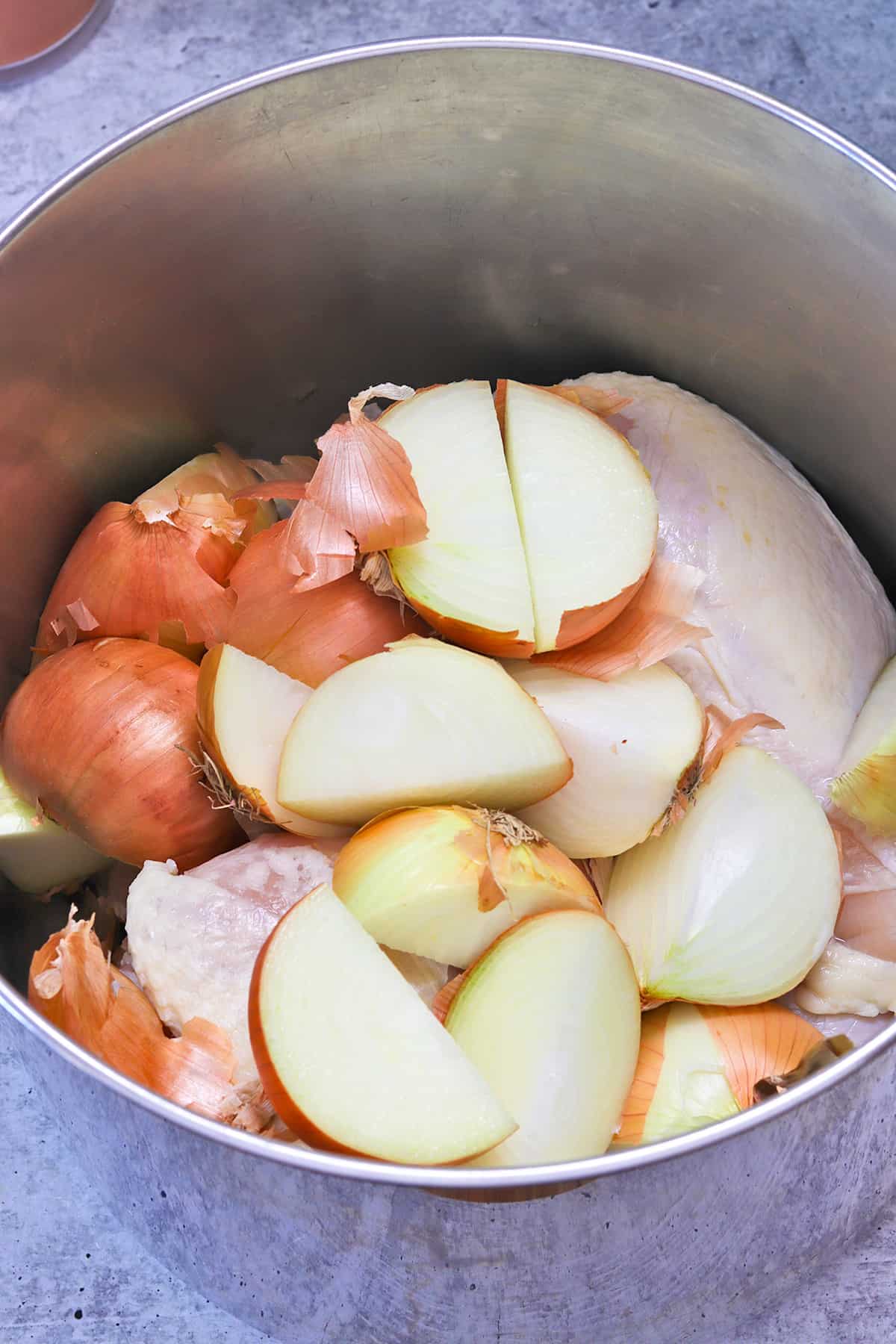

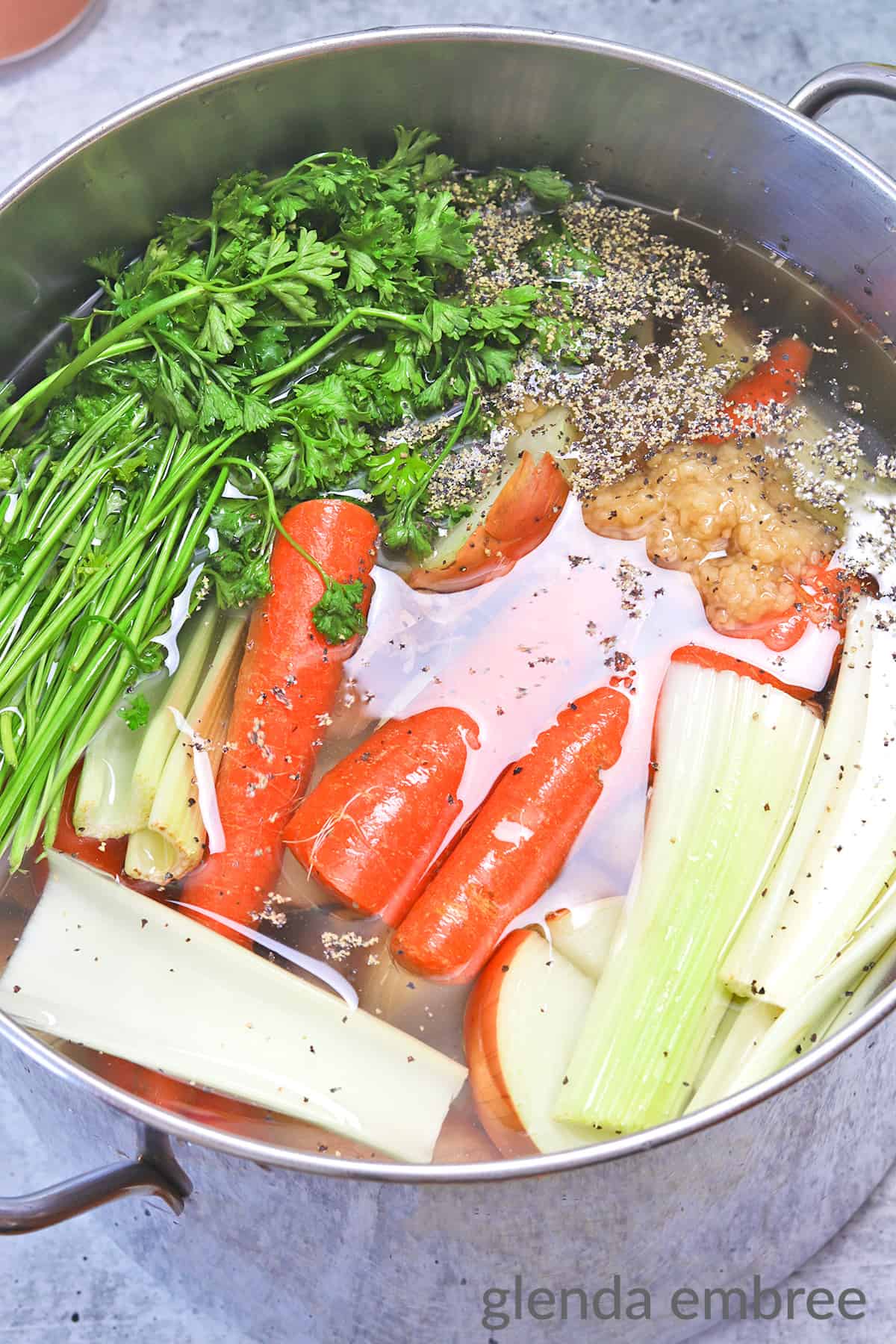
- Split Chicken Breasts (bone-in, skin-on) or a whole chicken
- Large Onions, any color
- Carrots
- Celery
- Fresh Parsley
- Garlic
- Bay Leaves
- Salt and Pepper
Broth vs Stock vs Bone Broth
We often use these terms almost interchangeably. So, is there really any significant difference between the three? Yes. And, as usual, mine doesn’t follow any one specific method. lol It’s sort of a combination of the broth and stock descriptions rather than one or the other.
Chicken Broth
Chicken broth is made by cooking chicken (usually bone in, skin on) in water with vegetables, herbs, salt and pepper. It is a thinner liquid that is well suited to making soups and stews. Chicken broth is also great for cooking rice, potatoes or pasta. Chicken broth doesn’t take as long to make as stock, requiring only 1 to 2 hours of simmer time. Chicken broth tastes good, just on its own.
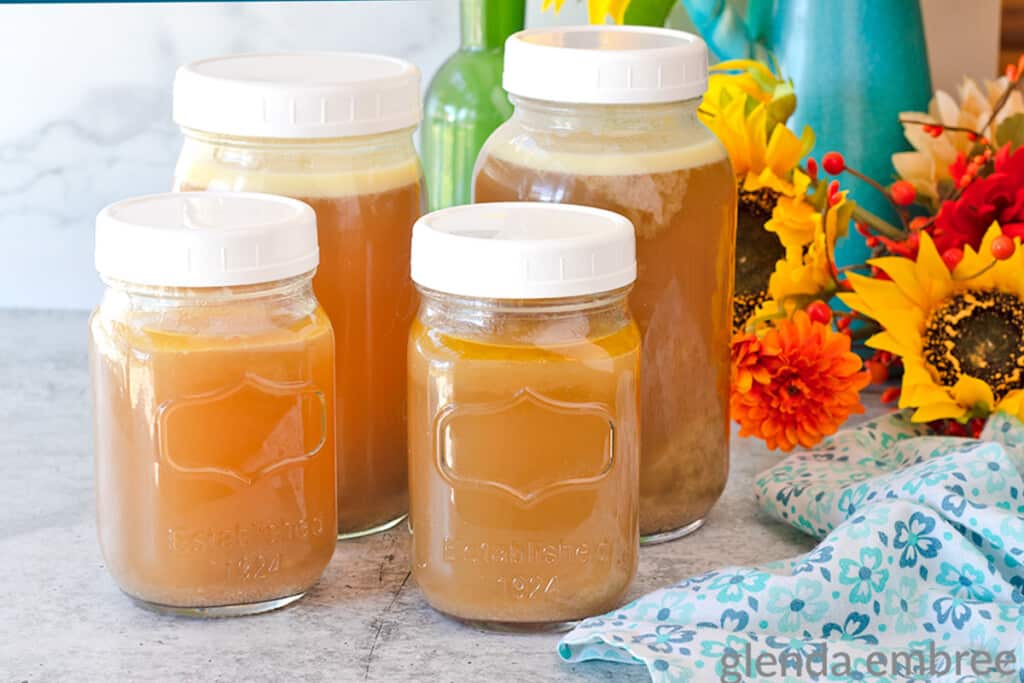
Chicken Stock
It takes longer to cook chicken stock than it takes to make chicken broth. It needs to simmer at least 4 hours, and even up to 6. Homemade Chicken Stock is typically made by simmering chicken bones with vegetables and perhaps a small amount of herbs and seasoning. It is not seasoned as intensely as chicken broth and on it’s own may taste bland or flat. Stock is usually thicker than chicken broth, too, as the longer simmer time allows the collagen/gelatin to be extracted from the bones. Chicken stock is great for making gravy and sauces because of its silky texture and the fact that it’s light seasoning complements, rather than overpowers, the dishes it’s used in.
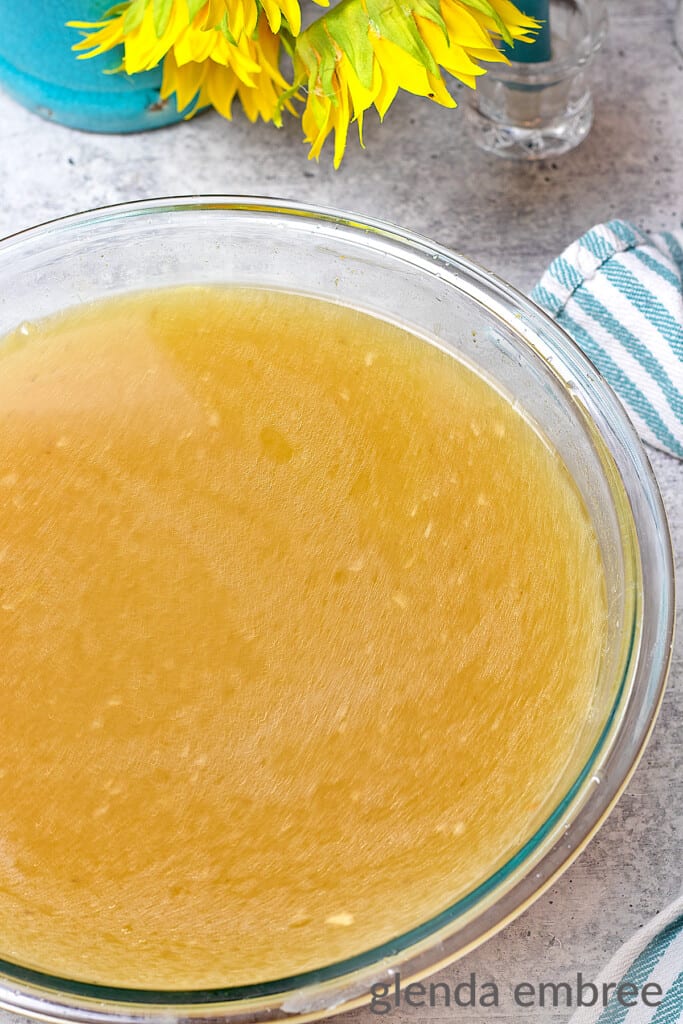
Bone Broth
It’s odd, really, that we call it broth. Bone broth is actually a type of stock. Chicken bone broth is made almost exclusively from bones. Not always, but usually. The bones can be cooked with vegetables, but it’s not typical. Especially when using commercial bone broth, my personal opinion is that the flavor is usually not great. It’s very easy to go OVER when making bone broth. It can be simmered anywhere from 12-48 hours. However, the longer it cooks and the more the bones break down, the more bitter the flavor can become. If you want a truly excellent flavored chicken bone broth, you would be better served to make one from scratch and carefully watch the timing, tasting as you go.
FAQs about Making Chicken Broth
It’s the water soluble proteins being released from the chicken as it cooks. They mix with the fats being rendered from the skin and with the water the chicken is being cooked in and that mixture floats. It’s perfectly safe. The foam may even turn brown or grayish as the chicken cooks. And as a matter of fact, it happens with any meat you boil at a high temperature. For the purposes of our chicken broth recipe, it will all be gone when the broth is strained at the end.
Prepping the Vegetables
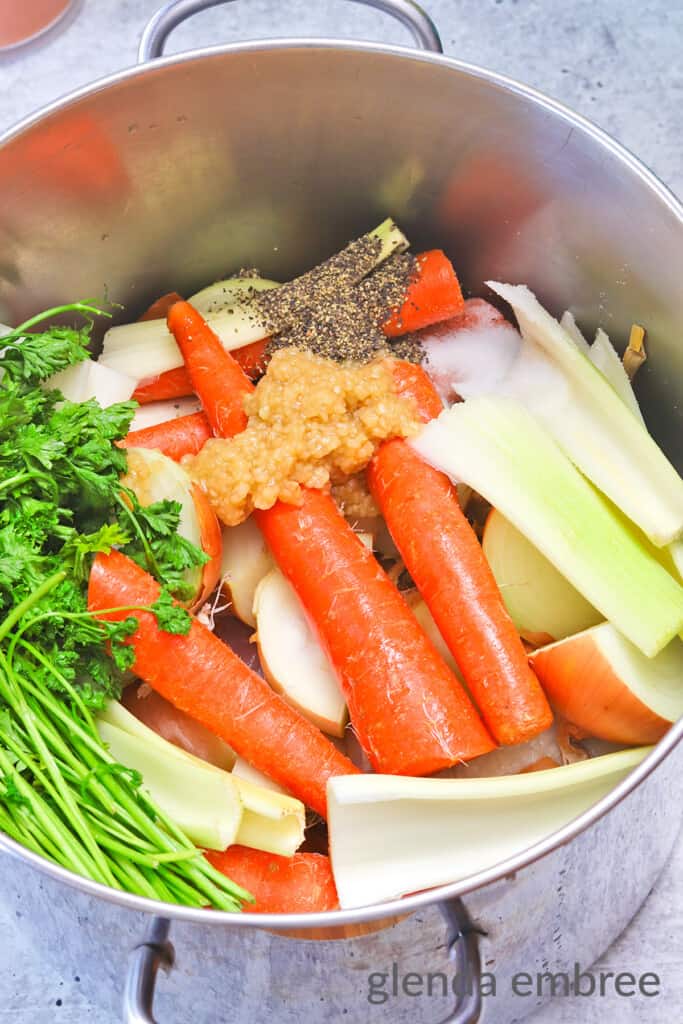
I wanted to add a quick note about the rough and ready method I use for prepping veggies for the stock pot. My method is to literally scrub them and chunk them up to toss in the pot.
Peeling the carrots, isn’t something I bother with. Nor do I peel my onions. I quarter them and toss them in the chicken broth pot. On many occasions, you’ll also find the entire bottom half of a celery plant in my soup kettle — not chopped at all.
Vegetable skins have nutrients. They also add gorgeous color, especially onion skins.
At the end of the day, we are cooking these veggies to get every last ounce of flavor and nutrition from them into our homemade chicken broth. The leftover vegetable pulp will all be strained out when the broth is done, so save yourself the extra work. Wash your vegetables, chop them coarsely and toss them in the chicken broth pot.
Because you’re cooking them until they wither away to nothingness, this is also a great time to use the older, less than optimal veggies at the back of the crisper drawer. Use them for something delicious and avoid the waste of just throwing them out.

Possible Variations and Substitutions
Different Chicken Parts
You could use chicken legs, thighs or even wings instead of the split chicken breasts that we choose. We simply prefer the texture and flavor of white meat and so that is what I cook.
But, any chicken part works for making broth. If you enjoy the flavor and texture of dark meat, or both white and dark, you can use a whole chicken or other chicken parts.
I have also been known to save the backbone from spatchcocking a whole chicken and freeze it to add to a chicken broth stock pot, later on.
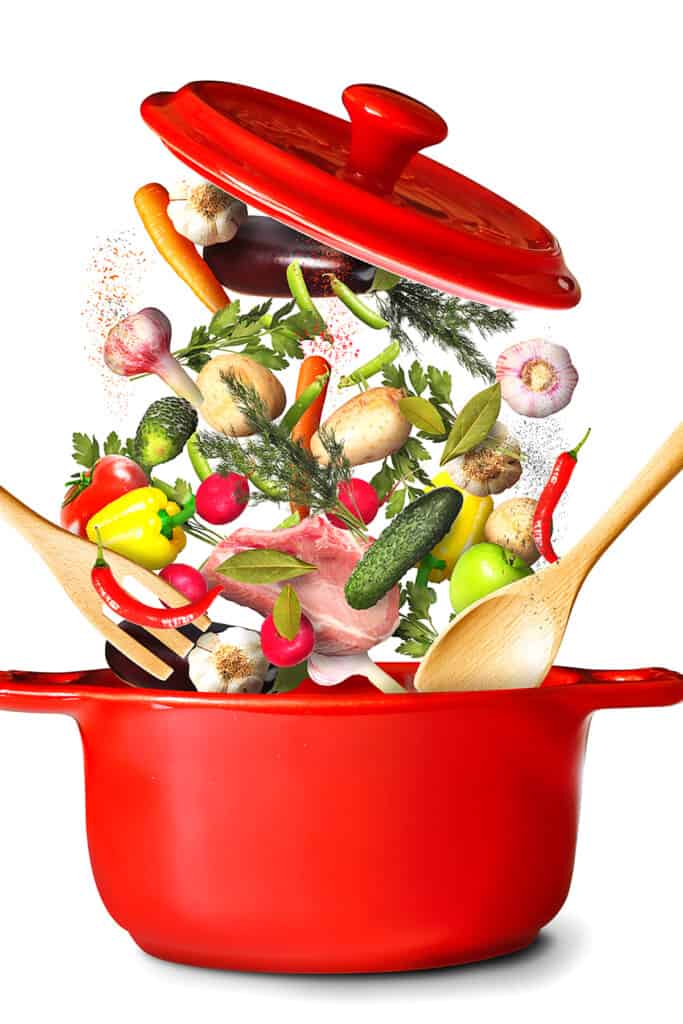
Different Vegetables
Of course. There is a distinctive flavor that comes from the combination of carrots, onion and celery. And they are a classic base for many, many broths and soups. I wouldn’t leave those out, but I do often add to them. So, if I have a zucchini on it’s last legs or the end piece of an jalapeno, I may very well throw them in. I have used bell pepper ends and pieces, too, as well as green onions, spinach, kale and parsnips. If you have other veggies on hand, that need to be used up they can only add more flavor to your broth. How can more flavor be wrong? Right?

Different Seasonings
I tend to keep my seasonings very basic and traditional, because I use this chicken broth in so many recipes that will already have their own seasoning profiles.
But, if you really love a specific herb or spice and think it would marry well with the dish you’ll use the homemade chicken broth in, you should add some.
Possibilities that work well in chicken broth are: poultry seasoning, rosemary, thyme, sage, oregano, marjoram and tarragon. There are certainly others, but that’s a great list to start with.

How to Use Homemade Chicken Broth
Homemade chicken broth is the natural choice for creating soups and stews. It’s perfect in my friend Sara’s slow cooker split pea soup or as the flavor base for casseroles like my Lentils and Rice Casserole. But it’s also fabulous for cooking rice, quinoa, dry beans, and even pasta.
You can use chicken stock to mash potatoes, too, if you need to keep your diet dairy free. And, a warm mug of flavorful chicken broth can clear stuffy heads and soothe sore throats.

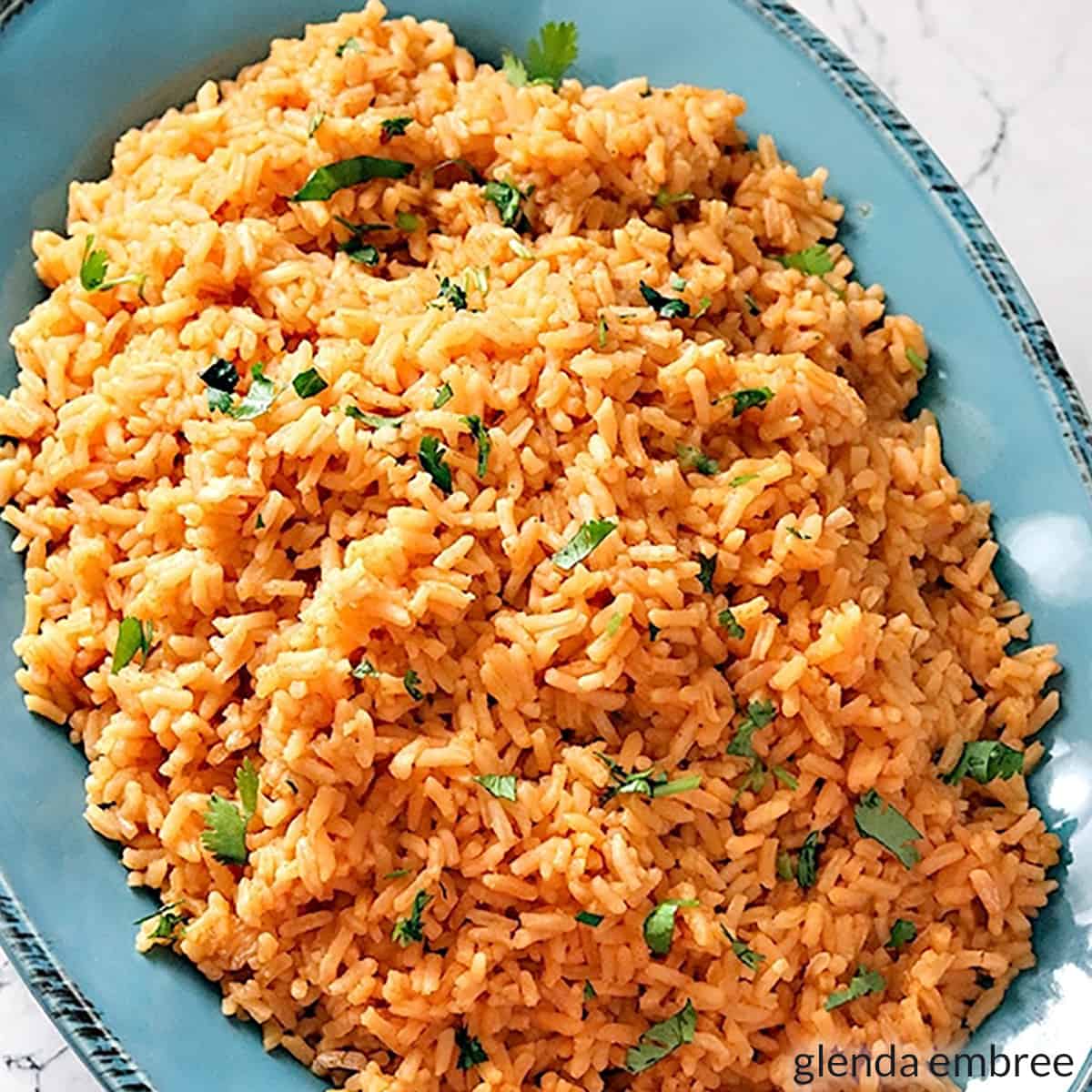
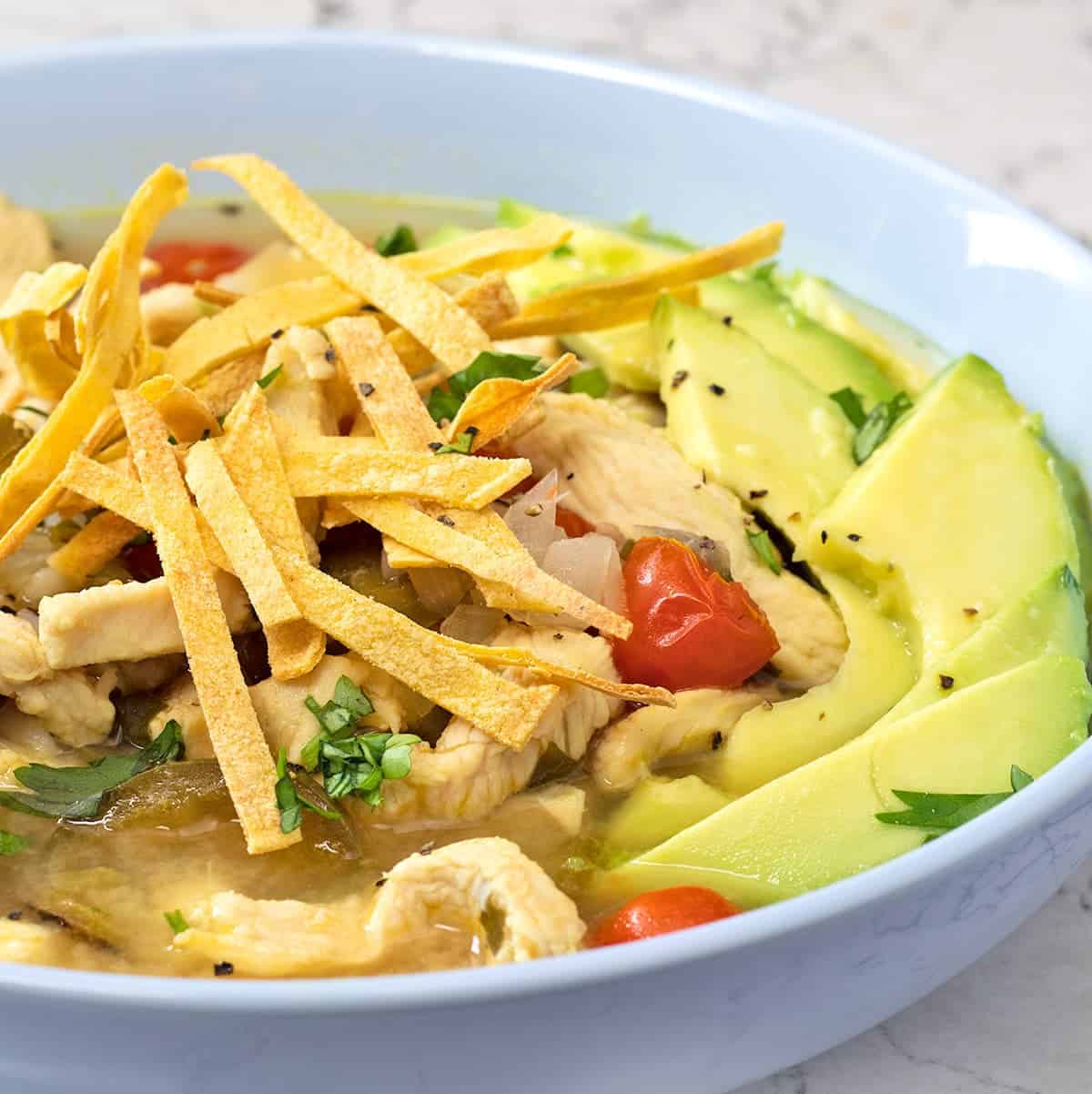

Try using homemade chicken broth in any of these delicious recipes!
- Homemade Refried Beans
- 10-Minute Mexican Rice
- Sausage and Cornbread Stuffing
- Avocado Lime Chicken Soup
- Zuppa Toscana
- Chicken and Corn Soup
- Slow Cooker Chicken Breasts
- Chicken Pot Pie Soup
- Slow Cooker Charro Beans
- Creamy Chicken and Noodles
- Stuffed Pepper Soup
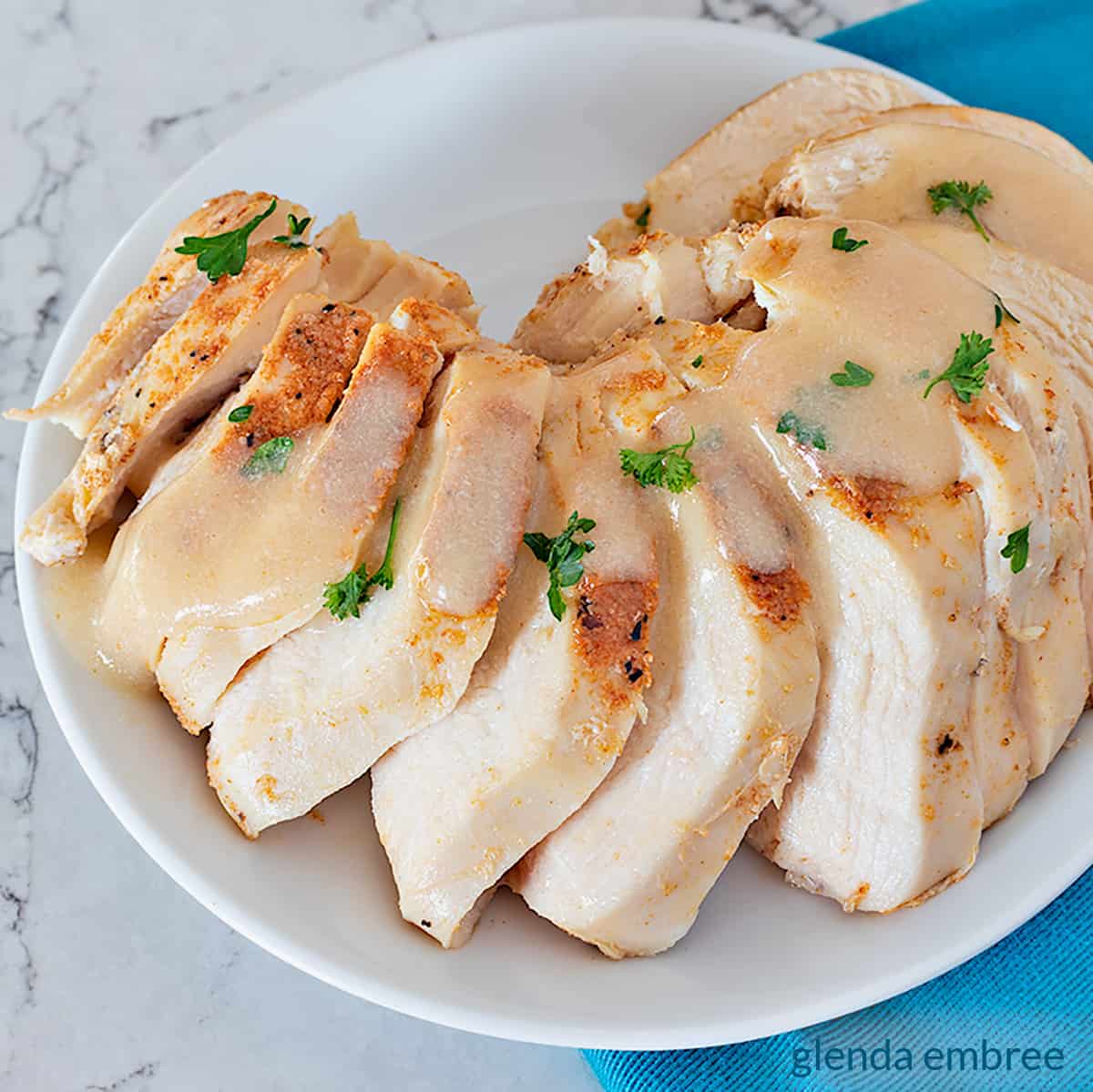
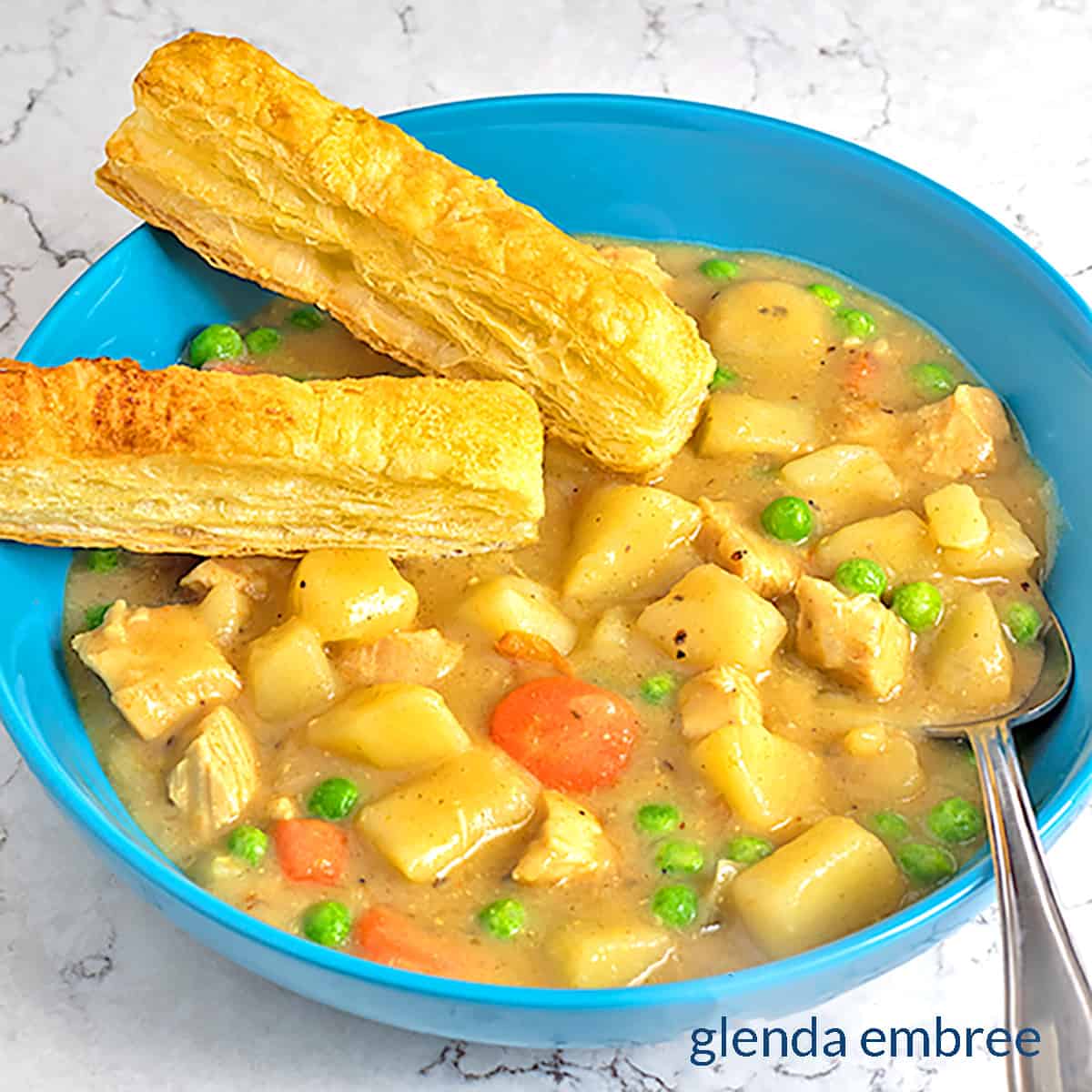

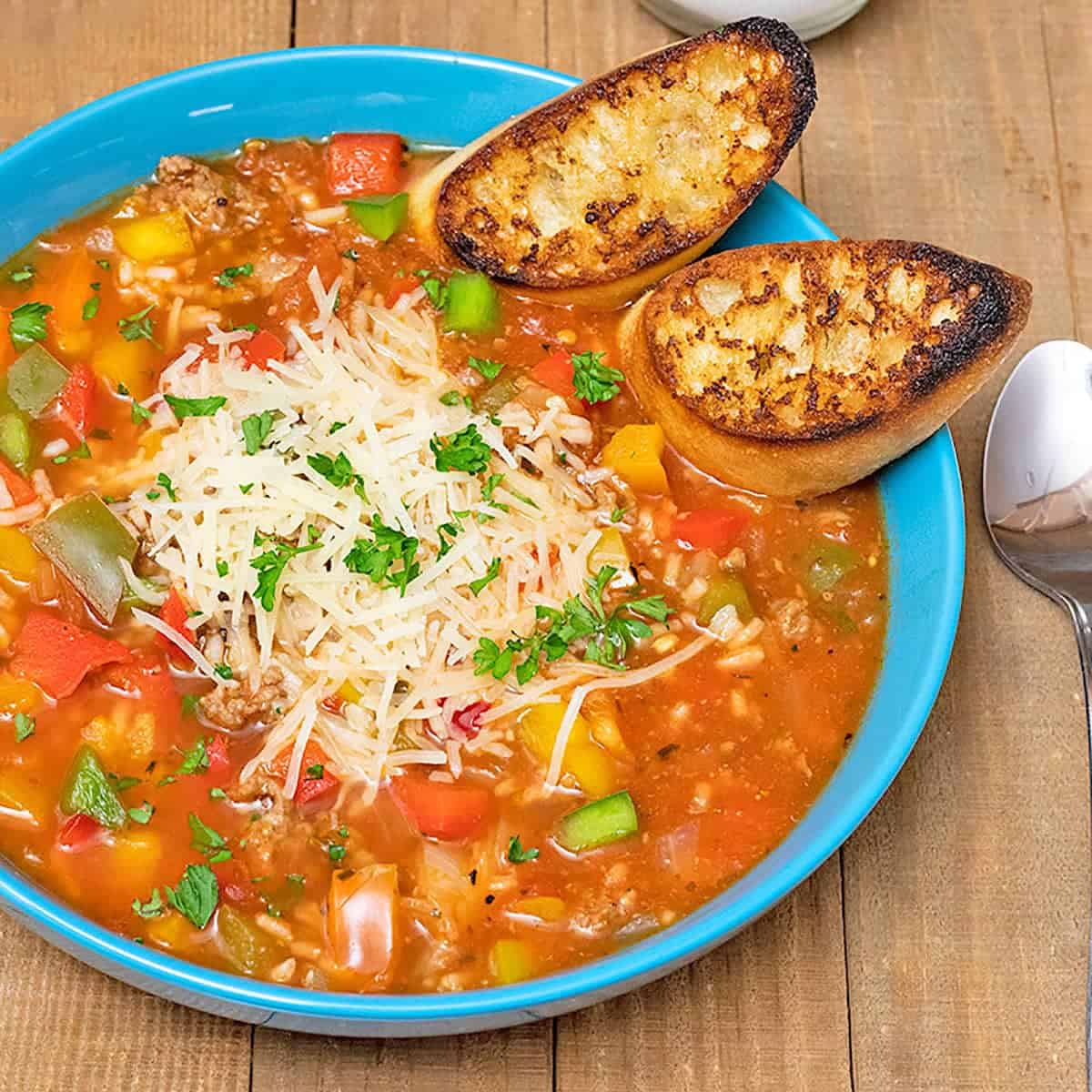
How to Use and Store the Meat
Another benefit of making Homemade Chicken Stock is the pre-cooked chicken you’ll have on hand to use in your favorite recipes.
The chicken can be stored in the fridge for up to 4 days or frozen for up to 6 months. Be sure containers or bags have as much air removed as possible and are sealed securely.
This chicken can be used in tacos, burritos and quesadillas. Chop it and use the pre-cooked chicken in salads, casseroles or rice bowls. It will be great in stir fry or in chicken fried rice. You can also use it to make scrumptious chicken salad or Buffalo Ranch Chicken Melts.
How to Store Homemade Chicken Broth
If you won’t be using your Homemade Chicken stock right away, you have a few options for storing it.
While canning is certainly one of those options, it’s not one I am proficient in and so I can’t adequately teach you to do that.
My preferred storage methods are in the refrigerator or in the freezer.
Chicken Broth can be stored in the refrigerator up to four days. Be sure it’s in an air-tight container.
Homemade Chicken Stock can also be frozen and I do this frequently. I like to freeze in my canning jars because I have an upright freezer and the jars sit neatly on the shelves.
The most important thing to remember about freezing in jars is that liquids expand. Leave at least 1/2″ of head room at the top of your jar. Place filled jars in the freezer WITHOUT their lids until the chicken broth is frozen. Then screw on the lids.
You can also freeze chicken broth in zip-top bags. Remove as much air as possible from the bag and store them flat until frozen. Then you can stand them on end like files in a filing cabinet to save freezer space.

How to Make Homemade Chicken Broth
Stage 1:
- Add the chicken pieces or a whole chicken to the bottom of your stock pot. I use a 12 quart stock pot for this recipe and it gets filled almost completely. So, I wouldn’t use anything smaller than a 12 quart stock pot or you won’t be able to get enough liquid in. (Cut the recipe in half if your pot is smaller.)
- On top of the chicken, add all the quartered onion pieces.
- Then, add the carrots, celery, garlic, onion, bay leaf, salt and pepper.
- Carry the stock pot over to the sink and fill it with water until the chicken and all the vegetables are covered by about 1-inch. Some things are gonna float, of course, but you want enough water to fully cover everything if you were to press them into the bottom of the pot.
- Once the pot is filled with water, set it on the largest burner on your stove top and set the burner to high.
- Bring the pot to a full rolling boil and then reduce the heat to medium. On my range, that’s about 5 or 6 (on a 1-10 scale).
- Let the pot continue to simmer on medium for 30 minutes.
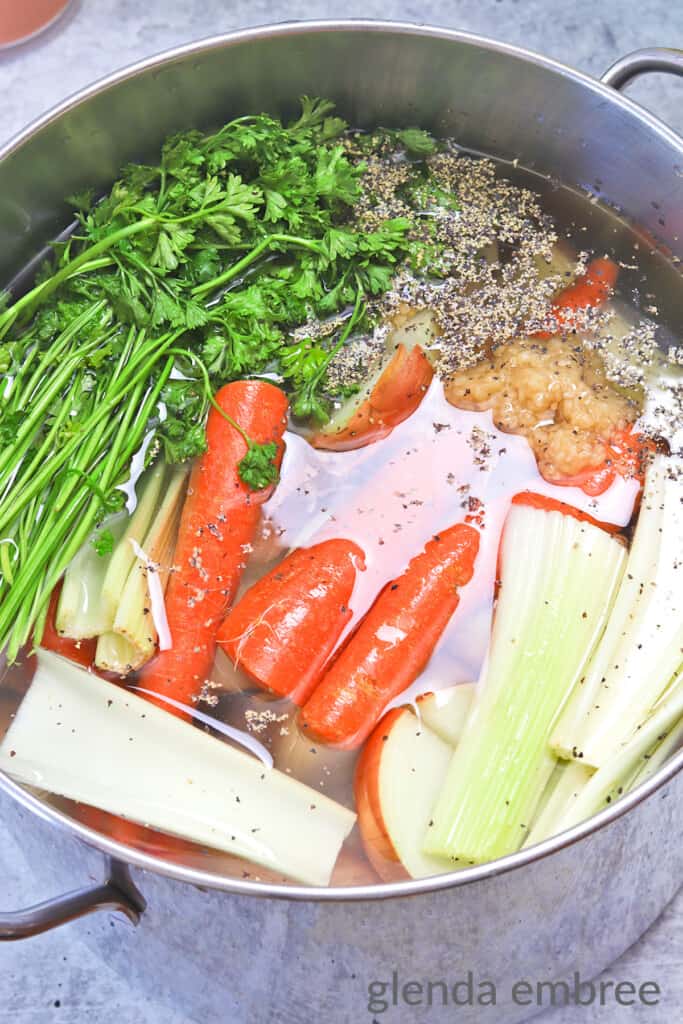
Stage 2:
- After 30 minutes, I check to make sure the chicken is cooked through (160° to 165° internal temperature). I leave the pot cooking on the stove, but remove the chicken breasts to a platter or cutting board.
- I remove the skin and bones from the chicken and put them back in the stock pot with all the vegetables. This step is to prevent the chicken from becoming dry, tough and overcooked or stringy, while still being able to get all the flavor and collagen from the skin and bones into my homemade chicken broth.
- While your homemade chicken broth continues to cook, cool the chicken meat and package for the fridge or freezer or to use in a recipe for dinner.
- After the bones and skin are added back to the pot, continue to cook for 2 1/2 hours. The vegetables will become soft and often break into smaller pieces. The chicken broth will have taken on color from the vegetables and from the little bit of fat in the skin.
- After 2 1/2 hours, remove the chicken broth from the heat.
- Use a strainer over a large bowl or another stock pot to strain all the bones, skin and spent vegetables out of your chicken broth. All the flavor and nutrition from those ingredients is in your luscious chicken broth, now, so the strained out parts can be discarded.
- This is the final opportunity, before cooling and storing, to check your chicken broth for seasoning. I almost always need to add a little extra salt and pepper at the very end. Taste and season accordingly.
Want to Save This Recipe?
Enter your email & I’ll send you the link so you always have it at your fingertips. Plus, I’ll send a collection of easy recipes to your inbox every Friday!
By submitting this form, you consent to receive emails from Glenda Embree.

Homemade Chicken Broth
- Total Time: 3 hours 10 minutes
- Yield: 12 cups 1x
- Diet: Gluten Free
Description
Homemade Chicken Broth is silky and flavorful. It’s chicken-y goodness with notes of flavor from veggies and herbs. It’s healthy, delicious and easy to make. It’s naturally gluten free and dairy free.
Ingredients
- 6 split chicken breasts (or a whole chicken)
- 2 large (or 3 medium) onions, any color
- 5 or 6 medium carrots
- 4 or 5 ribs of celery
- 1 bunch of fresh parsley, leaves and stems
- 2 Tablespoons minced garlic
- 2 Tablespoons salt
- 1 Tablespoon black pepper
- 3 bay leaves
Instructions
- Add the chicken pieces or a whole chicken to the bottom of your stock pot. I use a 12 quart stock pot for this recipe and it gets filled almost completely. So, I wouldn’t use anything smaller than a 12 quart stock pot or you won’t be able to get enough liquid in. (Cut the recipe in half if your pot is smaller.)
- On top of the chicken, add all the quartered onion pieces.
- Then, add the carrots, celery, garlic, onion, bay leaf, salt and pepper.
- Carry the stock pot over to the sink and fill it with water until the chicken and all the vegetables are covered by about 1-inch. Some things are gonna float, of course, but you want enough water to fully cover everything if you were to press them into the bottom of the pot.
- Once the pot is filled with water, set it on the largest burner on your stove top and set the burner to high.
- Bring the pot to a full rolling boil and then reduce the heat to medium. On my range, that’s about 5or 6 (on a 1-10 scale).
- Let the pot continue to simmer on medium for 1 hour.
- After 30 minutes, I check to make sure the chicken is cooked through (160° to 165° internal temperature). I leave the pot cooking on the stove, but remove the chicken breasts to a platter or cutting board.
- I remove the skin and bones from the chicken and put them back in the stock pot with all the vegetables. This step is to prevent the chicken from becoming dry, tough and overcooked or stringy, while still being able to get all the flavor and collagen from the skin and bones into my homemade chicken broth.
- While your homemade chicken broth continues to cook, cool the chicken meat and package for the fridge or freezer or to use in a recipe for dinner.
- After the bones and skin are added back to the pot, continue to cook for 2 1/2 hours. The vegetables will become soft and often break into smaller pieces. The chicken broth will have taken on color from the vegetables and from the little bit of fat in the skin.
- After 2 1/2 hours, remove the chicken broth from the heat.
- Use a strainer over a large bowl or another stock pot to strain all the bones, skin and spent vegetables out of your chicken broth. All the flavor and nutrition from those ingredients is in your luscious chicken broth, now, so the strained out parts can be discarded.
- This is the final opportunity, before cooling and storing, to check your chicken broth for seasoning. I almost always need to add a little extra salt and pepper at the very end. Taste and season accordingly.
- Prep Time: 10 min
- Cook Time: 3 hours
- Category: Soup
- Method: Stove Top
- Cuisine: American










